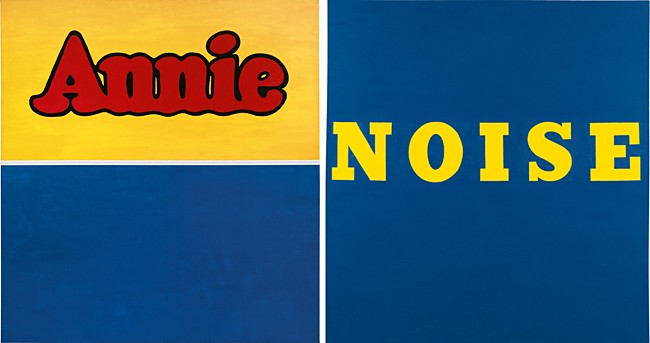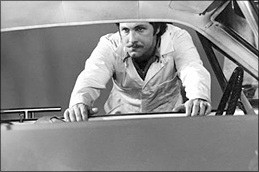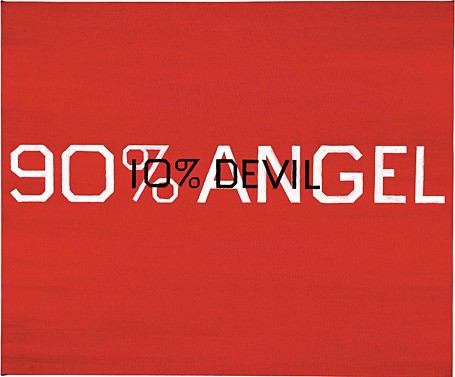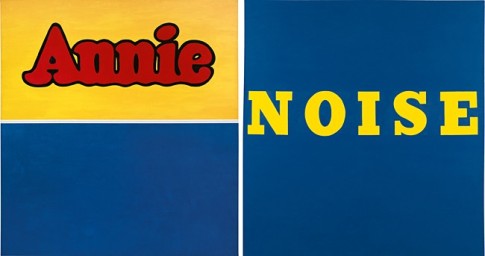
Ed Ruscha Annie, 1962/Noise, 1963 © Ed Ruscha 2010
Biography Ed Ruscha
1937
Edward Joseph Ruscha IV born in Omaha, Nebraska.
1941
Family moves to Oklahoma City, Oklahoma.
1947
Inspired by cartoonist Bob Bonaparte, a neighbourhood friend, Ruscha begins drawing cartoons based on real-life events.
Sees films including The House on 92nd Street and My Darling Clementine, which trigger his lifelong fascination with the movies.
1948
Attends painting classes at the Goetz Art School in Oklahoma City and, though he remains more interested in drawing cartoons, enjoys the smell of oil paint, turpentine and linseed oil.
1949
Aged 12, works as a gofer for the anarchic popular musician Spike Jones and his band, the City Slickers, when they play in Oklahoma City: ‘his stuff was the musical equivalent of a cartoon.’ 1
1950
Begins a paper round, which prompts an interest in the urban landscape: ‘I dreamed about making a model of all the houses on that route, a tiny but detailed model that I could study like an architect standing over a table and plotting a city.’ 2
1953
Enters high school in Oklahoma City, enrolling in art classes where he becomes interested in typography and printing and, in library books, discovers the work of Marcel Duchamp and other Dada and Surrealist artists.
1954
Aged 16, hitchhikes with a friend to Miami, Florida, via southern towns whose names – Dublin, Sweetwater, Vicksburg – he later includes in paintings.
1955
Joins US Naval Reserve.
1956
Receives first prize in graphic design from the Oklahoma City Chamber of Commerce. Graduates from high school. Drives to Los Angeles with his friend Mason Williams, where he attends Chouinard Art Institute (now California Institute of the Arts), enrolling in commercial design and fine art classes.
1957
Discovers the work of Jasper Johns and Robert Rauschenberg through black-and-white illustrations in magazines and is particularly influenced by Johns’ Target with Four Faces.
1958
Works for six months at the highly regarded Plantin Press where he learns to handset type. Becomes interested in all aspects of book production, developing ‘a respect for pages’.3
1959
Begins looking at photography: Robert Frank’s newly published Americans and earlier work by Walker Evans and Man Ray all have a profound effect on him.
1960
Graduates from Chouinard and begins working full time as a layout artist at the Carson / Roberts Advertising Agency in Los Angeles. Sees work by Jasper Johns at the Ferus Gallery in Los Angeles, which Ruscha acknowledges as a ‘crucial element’ in his life: Ferus ‘introduced artists to this side of the world who were previously never seen out here … It was truly avant-garde.’ 4
1961
April – September: travels extensively throughout Great Britain and Europe, photographing street scenes and making many small paintings and collages, some of which use words and street iconography.
On his return to Los Angeles, stops in New York, where he sees Roy Lichtenstein’s comicsrelated paintings, which greatly impress him. Begins a number of large paintings such as Boss in which single words are isolated against thickly impastoed monochromatic fields. Abandons idea of becoming a commercial artist and leavesCarson/Roberts in order to devote himself exclusively to painting.
1962
July: Ferus Gallery presents ‘Andy Warhol: Campbell’s Soup Cans’, Warhol’s first solo exhibition of photographic silk-screen paintings. September: New Painting of Common Objects exhibition at Pasadena Art Museum includes Ruscha along with Andy Warhol, Roy Lichtenstein and Joe Goode, among others.
Completes Large Trademark with Eight Spotlights, his first painting with illusionistic threedimensional lettering.
1963
Starts his own publishing company and publishes his first book, Twentysix Gasoline Stations, in an edition of 400 copies. This consists of 26 blackand-white photographs of petrol stations, which he had taken the previous year while driving between Los Angeles and Oklahoma City along Route 66. Between now and 1978, he will publish a further fifteen artist’s books.
First solo exhibition opens at Ferus Gallery in LA and includes Annie and Large Trademark with Eight Spotlights. Meets Marcel Duchamp who, at the age of 79, is given his first large-scale American retrospective; a landmark exhibition, organised by Walter Hopps for the Pasadena Art Museum.
1964
Flames, a major motif in Ruscha’s work in the 1960s, make their first appearance in paintings such as Norm’s, La Cienega, on Fire.
1965
The Ferus Gallery presents Ruscha’s third solo exhibition, a series of bird and fish paintings begun in 1963. These large-format works depict the sort of subjects featured in the American sporting magazine Field and Stream, often becoming absurdly surreal.
Using the pseudonym ‘Eddie Russia’ (a pun on his frequently mispronounced surname), he begins to work as a layout artist for Artforum magazine,whose editorial offices are located above the Ferus Gallery. The new Los Angeles County Museum of Art opens on Wilshire Boulevard; Ruscha photographs it from a helicopter and begins the large painting, Los Angeles County Museum of Art on Fire, which is completed in 1968.
1966
Creates his first ‘liquid word’ painting, Annie, Poured from Maple Syrup, the beginning of a series that continues through 1969. Publishes Every Building on the Sunset Strip, a photographic panorama of the Sunset Strip in West Hollywood, presented as an accordion-folded book with the north side of the street running across the top of the page and the south side, upside down, along the bottom. Included in Los Angeles Now at the Robert Fraser Gallery, London, his first European exhibition.
1967
Marries Danna Knego in Las Vegas, Nevada. First solo exhibition in New York, Gunpowder Drawings, opens at Alexander Iolas Gallery. Publishes Royal Road Test, made with writer and musician Mason Williams and photographer Patrick Blackwell, which documents the fate of a vintage typewriter that is thrown from a speeding car into the Californian desert.
1968
Solo exhibition at the Irving Blum Gallery in Los Angeles. The invitation to the opening takes the form of a telegram announcing that the show features ‘A NEW PAINTING TITLED ‘L.A. COUNTY MUSEUM ON FIRE,’… STOP LOS ANGELES FIRE MARSHALL SAYS HE WILL ATTEND STOP SEE THE MOST CONTROVERSIAL PAINTING TO BE SHOWN IN LOS ANGELES IN OUR TIME STOP’
Birth of his son, Edward Joseph Ruscha V.
1969
Works on paper and two paintings, including Glass of Milk, Falling included in the large survey exhibition Pop Art at the Hayward Gallery, London.
Publishes the portfolio Stains, in which he uses common organic substances – household products, food and drink, and bodily fluids – in place of conventional media: ‘the idea of using something that stains rather than a paint that sits on the surface of a canvas was my discovery, for myself at the time.’ 5
1970
Invited to London by the pioneering print publishers Editions Alecto, Ruscha produces a portfolio of screenprints using organic products – blackcurrant pie filling, salmon roe, pickles, raw egg, chocolate syrup, caviar, axle grease, daffodils, baked beans and tomato paste – in place of usual printers’ inks. Creates Chocolate Room, an installation for the 35th Venice Biennale, using chocolate silkscreened onto 360 sheets of paper, which are stuck like roof-tiles on the gallery walls.
Makes his first film, Premium (24’, colour / sound, 16mm), based on a ‘harebrained story’ by Mason Williams. Makes no paintings this year and tells the critic David Bourdon: ‘I can’t bring myself to put paint on canvas … I find no message there anymore.’6
1971
Produces only 5 paintings during this year, four of which experiment with organic substances; the fifth completes an earlier canvas.
In the exhibition 11 Los Angeles Artists at the Hayward Gallery, shows twelve recent drawings made with gunpowder and other substances such as ivy, chilli pepper, iodine and bourbon.
1972
Designs the poster for, and participates in, Document 5, in Kassel, Germany.
Edward Ruscha (Ed-werd Rew-shay) Young Artist, a major survey exhibition of drawings, prints, and books, is organised at Minneapolis Institute of Arts, Minnesota.
1973
Begins to use phrases, rather than single words, in paintings and graphic works.
1975
Makes his second (and last) film, Miracle (28’, colour/sound, 16mm), about a car mechanic who achieves salvation by abandoning everything in the outside world for the sake of a shiny red Ford Mustang.
1976
For the Venice Biennale, Ruscha creates an installation entitled Vanishing Cream, consisting of letters written in Vaseline petroleum jelly on a black wall. No other paintings are completed this year. Is asked to play the part of an artist in the film Welcome to L.A., directed by Alan Rudolf. Ultimately, his scenes are not used.
1977
Creates the billboard painting The Back of Hollywood. Installed in a car park opposite the Los Angeles County Museum of Art, the billboard is designed to be read in the rear-view mirror of a moving car.
Begins the series of ‘grand horizontal’ paintings, usually depicting words, phrases, and diagrams against technicolor sunsets, some of which are over thirteen feet wide.
1980
Begins to develop his own typeface, in which curved letter forms are squared-off (as in the Hollywood sign), which he calls ‘Boy Scout Utility Modern’.
1982
A major retrospective, The Works of Edward Ruscha, is organised by the San Francisco Museum of Modern Art and opens in March. The exhibition travels to the Whitney Museum of American Art and three other venues in the United States and Canada.
Work is included in Documenta 7, in Kassel, Germany.
1983
Initiates technique of reverse stencilling in painting, in which letters appear as white gessoed canvas, having been masked off before the ground was painted.
1984
Plays a small but conspicuous role in the comedydrama film Choose Me, directed and written by his friend Alan Rudolph.
1985
Begins a series of ‘City Lights’ paintings, where grids of bright spots on dark grounds suggest aerial views of the city at night.
Moves from his Western Avenue studio in Hollywood (which he has had since 1965) into a large studio space on Electric Avenue in Venice, California, in order to begin work on Words Without Thoughts Never to Heaven Go, a series of murals for the rotunda of the newly built Miami-Dade Public Library in Florida, designed by Philip Johnson.
1986
Begins a series of wordless ‘silhouette’ paintings, using a spray gun for the first time; this leads him more or less to abandon oil paint in favour of acrylic.
1988
Birth of his daughter, Sonny Bjornson
1989
Edward Ruscha: Paintings, organised by the Musée national d’art moderne, Centre Georges Pompidou, Paris and Museum Boijmans-Van Beuningen, Rotterdam, is also shown at Centre Cultural de la Fundació Caixa de Pensions, Barcelona; Serpentine Gallery, London; and The Museum of Contemporary Art, Los Angeles.
1994–95
Commissioned to create a 70-panel, 130-yard-long mural for the atrium of the new Denver Central Library, Colorado, designed by Michael Graves. The 360° panorama features images of the historical American West, anamorphic writing (including names of Indian chiefs and local celebrities such as Soapy Smith) and voice prints; ‘acoustically vertical images’ which are oscillographs of such sounds as buffalo stampeding and a lark bunting, trilling.
1997
Completes Picture Without Words, a 23-foot-high mural commissioned for the new Getty Center in Los Angeles. Using a motif that has interested him for several years, it depicts light pouring into a room through a high window and forming a dazzling white pool on the floor. Paints first ‘Mountain’ painting – the start of a decade-long series.
1998
The J. Paul Getty Museum in Los Angeles organises an exhibition of Ruscha’s works on the theme of light.
1999
Ed Ruscha: Editions 1959 –1999, catalogue raisonné of prints, editions and artist’s books, published by Walker Art Center, Minneapolis.
2000
Ruscha’s graphic archive of 325 editioned prints and over 800 working proofs is acquired by the Fine Arts Museums of San Francisco for its graphic art collection. A major retrospective of Ruscha’s career is organised jointly by the Hirshhorn Museum and Sculpture garden in Washington, D.C., and the Museum of Modern Art in Oxford. Between its showings in Washington (June – September 2000) and Oxford (October 2001 – January 2002), it travels to the Museum of Contemporary Art, Chicago, The Miami Art Museum, and the Modern Art Museum of Fort Worth, Texas.
2001
Elected to The American Academy of Arts and Letters as a member of the Department of Art. The exhibition Ed Ruscha – The Mountains is shown at Inverleith House, Royal Botanic Garden, Edinburgh. Reflecting on his 40-year career, he says: ‘I see that what I’m doing today, I was doing when I was 18…I’m still responding to the convulsive life of things that happen out on the street: car culture, American life, word signs, typography. I’m still puzzled by it all.’7
2003
The first volume of a projected eight-volume catalogue raisonné is co-published by Gagosian Gallery and Steidl.
2004
The Whitney Museum of American Art, New York, organises Cotton Puffs, Q-Tips[R], Smoke and Mirrors: The Drawings of Ed Ruscha and a smaller touring exhibition, Ed Ruscha and Photography. Elected an Honorary Academician of the Riyal Academy of Arts, London.
2005
Represents the US at the 51st Venice Biennale, with the 10-painting series Course of Empire. Is the featured artist at the Royal Academy of Arts’ 237th Summer Exhibition.
Publishes Then & Now, his first photo-based artist’s book since 1978.
2009
As part of their refurbishment of the White House’s public rooms, Barack and Michelle Obama borrow Ruscha’s 1983 painting I Think I’ll… from the National Gallery of Art in Washington.
Publishes Jack Kerouac: On the Road.
References
1 Ed Ruscha, quoted in Kristine Mc Kenna, ‘The Sentimental Musical Tastes of Ed Ruscha’, Los Angeles Times, 19 June 1988, Alexandra Schwartz (ed.), Ed Ruscha: Leave Any Information at the Signal. Writings, Interviews, Bits, Pages, MIT Press, Cambridge, Mass., 2002, p. 272.
2 Ed Ruscha, quoted in Siri Engberg and Clive Phillpot, Ed Ruscha: editions 1959 – 1999, exh. cat., Walker Art Center, Minneapolis, 1999.
3 Ed Ruscha, quoted in Paul Karlstrom, ‘Interview with Edward Ruscha in his Western Avenue, Hollywood Studio’, California Oral History Project, Archives of American Art, Smithsonian Institution, 1980 – 81, in Schwartz, op. cit., p. 111.
4 Ed Ruscha, quoted in Barbara Isenberg, ‘Conversation with Edward Ruscha’, B. Isenberg, State of the Arts: California Artists Talk about Their Work, William Morrow, Harper Collins, New York, 2000, p. 197.
5 Ed Ruscha, excerpt from an audio program for MoMA2000: Open Ends (1960 – 2000), The Museum of Modern Art, New York, 2000.
6 Ed Ruscha, quoted in David Bourdon, ‘Ruscha as Publisher [or All Booked Up]’, Art News, vol. 71, April 1972, in Schwartz, op. cit., p.40).
7 Ed Ruscha, quoted in Elizabeth Mahoney, ‘Top of the Pops’, The Guardian, 14 August 2001.



